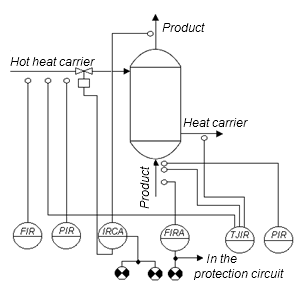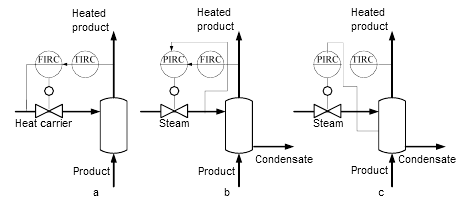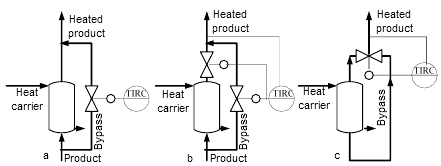Managementof thermal processes oftheliquid heating
Generalaboutliquid heating.
Let's consider the heat management process principles with control surface shell and tube heat exchanger as an example (Fig. 1), which is supplied with the heat carrier and the heated product. Indicator of the effectiveness of the process is the product temperature at the outlet of the heat exchanger and the control objective is to maintain this temperature at a certain level. Temperature dependence on process parameters can be found from the heat balance equation:
![]()
Where: ![]() — expenditureof the productandthe hot heat carrier;
— expenditureof the productandthe hot heat carrier;
![]() — specific heat capacity of the productandthe hot heat carrier;
— specific heat capacity of the productandthe hot heat carrier;
![]() — temperature of the productandthe hot heat carrier at the entrance of the heat exchanger;
— temperature of the productandthe hot heat carrier at the entrance of the heat exchanger;
![]() — - temperature of the hot heat carrier at the outlet of the heat exchanger;
— - temperature of the hot heat carrier at the outlet of the heat exchanger;
Solvingthe heat balanceequation for![]() we get:
we get:

Figure 1. Typical schemeof automation ofthe heating process
Heat carrier expenditure ![]() is easilystabilizedand can be usedfor theintroduction ofeffectivecontrol interventions. Product expenditure
is easilystabilizedand can be usedfor theintroduction ofeffectivecontrol interventions. Product expenditure ![]() is determined by other technological processes, rather than heating process, so it cannot be stabilized or used to make control interventions; with the change of
is determined by other technological processes, rather than heating process, so it cannot be stabilized or used to make control interventions; with the change of![]() strong disturbances enter the heat exchanger. The temperatures
strong disturbances enter the heat exchanger. The temperatures ![]() andspecific heat capacities
andspecific heat capacities ![]() are determined bytechnological conditionsof other processes, so it is impossibleto stabilizethem inthe heating process. Not liquidated perturbations also contain ambient temperature changesandheat transferproperties of thewall due tosalt depositionandcorrosion.
are determined bytechnological conditionsof other processes, so it is impossibleto stabilizethem inthe heating process. Not liquidated perturbations also contain ambient temperature changesandheat transferproperties of thewall due tosalt depositionandcorrosion.
Analyzing thecontrol object we can see thatmost of thedisturbancescannot be eliminated. In this regard the temperature ![]() should betakenas a control variableand carry out regulating effectby expenditure
should betakenas a control variableand carry out regulating effectby expenditure ![]() changing.
changing.
The heat exchangeras a temperature controlobjecthaslongerdelay, so you should pay special attention tothe selection ofthe sensorinstallation locationand regulatorylaw. To reducetrafficdelaystemperature sensorshould be placedas close as possibleto the heat exchanger. To eliminatethe lag,applicationcontrollers withprefixedand actuatorswithpositioners can be significantly effective.
As thecontrolledvariablesheat carrier flow rate should be taken, their final and initialtemperature, pressure.Knowledge ofthe current values ofthese parametersis necessaryfor the normalstart-up, commissioningand operationof the process. Itis also requiredto know expenditure ![]() to calculate thetechnical and economic parametersof the process, and the expenditure
to calculate thetechnical and economic parametersof the process, and the expenditure ![]() andtemperature
andtemperature ![]() for theoperational management ofthe process.
for theoperational management ofthe process.
The temperature ![]() andthe expenditure of the product should be controlled. Due to the factthat a sharpdrop inexpenditure of
andthe expenditure of the product should be controlled. Due to the factthat a sharpdrop inexpenditure of ![]() isoftena causeof failure ofthe heat exchanger, the protection devicein this case shouldoverlap thehot heat carrierline.
isoftena causeof failure ofthe heat exchanger, the protection devicein this case shouldoverlap thehot heat carrierline.
All the argumentsin relation tothe heating processare validtocoolingprocess.The object ofthe controlin this case will beshell tubeheat exchanger, which is supplied withcoolantandcooledproduct; efficiency indicatoristhe final temperature ofthe product, andthe aim ofthe controlis maintainingthis temperatureat a predeterminedvalue.The maincontrolunitwillcontrolthe finaltemperatureof the cooledproduct, theregulationwill be implementedby changing thecoolantflow.
Cascade-related regulation
The use ofdouble-circuit automaticcontrol systemssignificantly improves thecontrolquality of the finalproduct temperature, if theparameter, with strongindignationfor theheat transfer process selected as the auxiliary adjustable variable.
Oftenthe coolantflow (Fig. 2) is chosenas an auxiliaryparameter;Ifcoolantissteam withvariable pressure, it is preferable tomeasure thepressure ofthe coolantor the pressurein the intertube space.
The last optionshould be usedat variabletemperatureandflow-heated, as the pressurein the intertubespaceis muchless thaninertialparameterthan the finalproduct temperature.

Figure 2. Double-circuitsystemof regulationof the heating processwith the use ofan auxiliaryvariablecoolantflow rates(a),the vapor pressure of(b)and the pressurein the intertube space (c)
Regulationthrough bypassing theproducts
To controlsystems in which change ofthe heat capacitor flow rateis not possible,bypassmethod is used.
Regulating effectinthis case,is made by changingbypassedproductflow(Fig. 3a).
Since themovement ofthe regulatory bodyin the bypass linestillleads to somechanges inthe productflowat highrequirements forconstancyof theflowtwo membraneactuatorsof different type are installed(Figure3b). A similareffect is achieved byinstallinga three-waymixing valve(figure3c).
Controlmethodimproves thedynamicbypasscharacteristicof the system,as thischainofcontrol ofthe heat exchangeris excluded.

Figure3.Temperature controlschemechanges inproductflowa bypass pipe: a — viaonevalve; b — with twovalves;c — viathree-way valve
Regulationby changingconsumptionof heating steamcondensate
If the heat exchangeris operated atpartialcondensatepour,regulatory influencescan be insertedby changing condensateconsumption,which leadsto a change inthe level ofcondensatein the heat exchanger.In this caseheat exchange surfaceis distributedbetween thecondensing vaporand the producton the onehand, and thecondensate and theproduct — on the other.The intensity of theheat exchange, and then the temperature of the productleaving the heat exchangerchanges. This systemallows increasingheat exchangerefficiencyby 6–7 % due to the full utilization ofthe heatof steam and condensate. However,due to the largedelaysthe system canbe recommendedonlyin the absence ofsuddendisturbing influences.
Process controlin the heat exchangersof mixing
The slightest change inthe parameters ofthe heat carrierduringdirect mixingtwo or moreliquids, result insignificant andrapid changes intemperature ofthe finalproduct, so in the management ofheat exchangers of mixingconnected regulation are often usedand ratioof the flow rateandthe productwith the correction ofthe producttemperature.
Automation ofprocess ofheatingcombustibleproducts
To eliminatean explosion hazardin superficialheat exchangersit isnecessary to providemethods and means to preventmutual penetration ofheat carrier(ifit couldresult in an explosiveenvironment).This applies particularly totheheat exchangersin whichthe heat carrierfuelpressure higherthan the pressure ofthe incombustible heat carrier.
By reducing thelevel offlammable liquidheatedin the heat exchangerand unsheathingthe heat transfer surface(which can lead to overheating,dryingand decompositionof flammable productand the development ofuncontrollable processes) there should betriggeredthe alarmlock the device(the latter should stop theflow ofheating agent).







